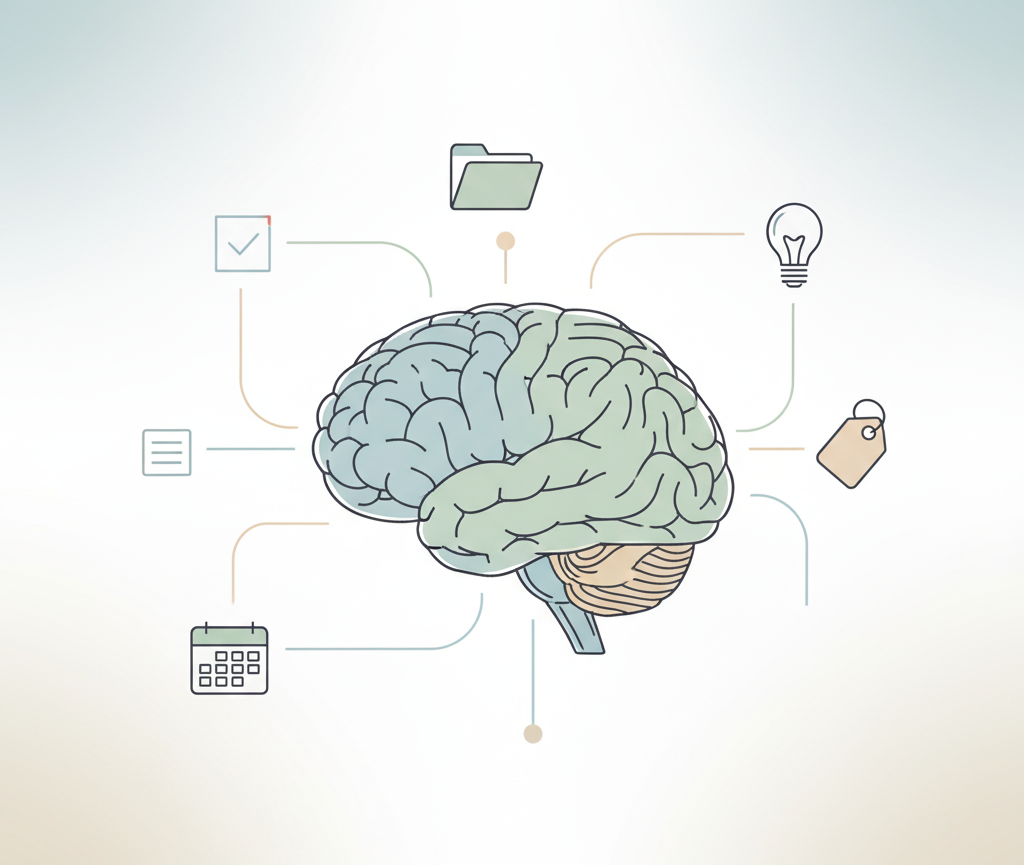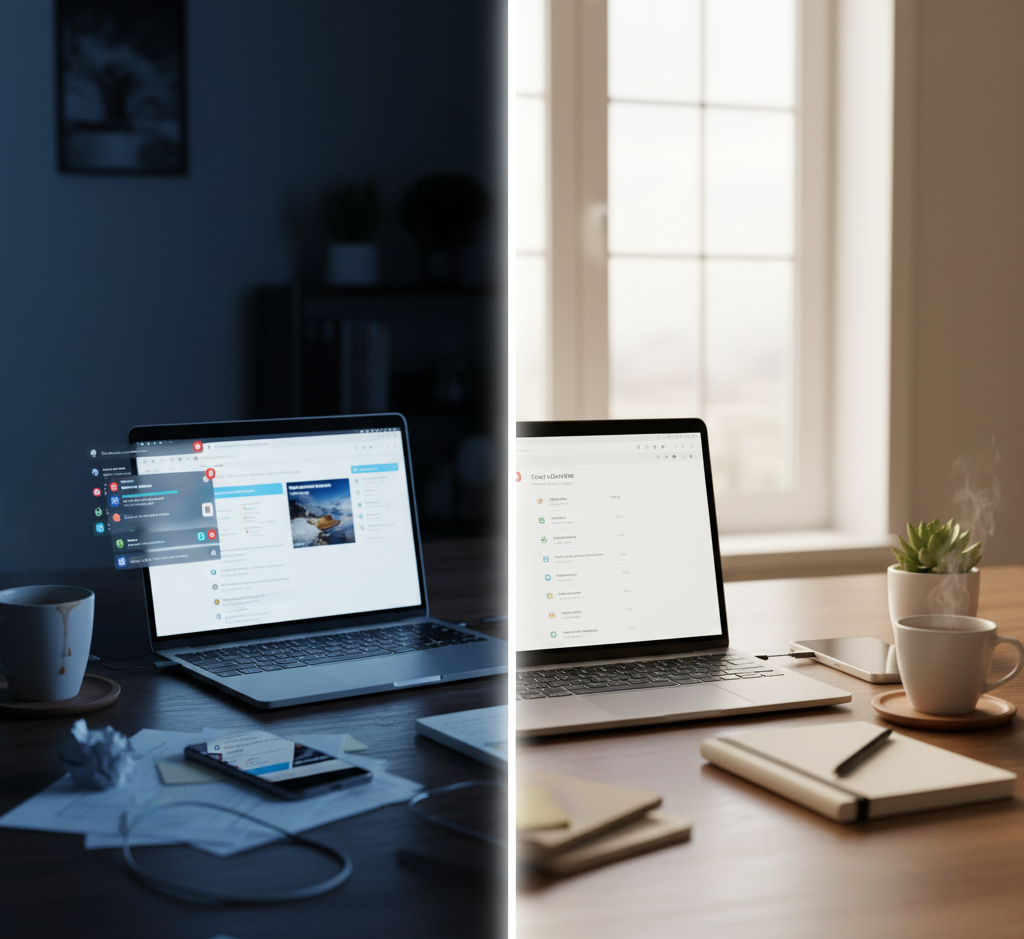Reclaim your focus, simplify your workflow, and make space for what truly matters.
How often have you turned on your phone to check one thing—and found yourself juggling three apps, three tabs, and perhaps three different tasks at once? It happens to all of us. We tell ourselves we’re being efficient, but deep down we feel scattered. For years I wore multitasking like a badge of honour—until I discovered that what feels like productivity is often mental chaos.
Research reveals that our brains aren’t wired for true multitasking. Rapid switching between tasks creates hidden costs to focus, memory, and flow. APA+2PMC+2
In this article you’ll learn what stop multitasking really means, why it matters, and what to do instead. Think of it as a calm guide to designing a workflow that honours your attention rather than fragments it.
Why Multitasking Hurts Your Productivity
Understanding the Myth of Multitasking
It’s tempting to believe we can do everything at once. But the truth is our brain often shifts—rather than does—multiple tasks simultaneously. Verywell Mind+1 Each time we switch paths we incur a mental cost.
Key takeaway: You don’t multitask—you task-switch.
The Switch Cost Explained
- Research shows switching between tasks can cost up to 40% of productive time. Wake Forest News+1
- Heavy multitaskers often perform worse in sustained attention and memory tasks—even when doing only one task. PMC+1
- Constant context switching prevents deep flow and raises stress levels. PMC
Why You Feel Busy—but Not Productive
You may finish the day checking boxes—but feel like you didn’t accomplish what mattered. The culprit? Multitasking creates illusion of progress, not real momentum.
I used to drift between answering emails, switching tabs, chatting, and sketching ideas—only to realise I never entered a deep working state. Recognising that pattern was the first step to change.
Embrace Single-Tasking: What to Do Instead

Start with Time-Blocked Work Sessions
If multitasking is the problem, then one of the best antidotes is time-blocking. Schedule time for one task, and commit. Wikipedia
Steps to implement:
- Choose a task and block 25-60 minutes of uninterrupted time.
- Turn off or mute notifications, put your phone out of sight.
- Work only that task; when done, take a short break before moving to the next.
Pro tip: I start each morning with a 90-minute block on a single meaningful project—everything else waits. The difference is like night and day.
Key takeaway: Work in dedicated blocks, not fragmented bursts.
Introduce a “Pre-Task Buffer”
Before switching from one task to another, introduce a short pause—1-2 minutes—to reset focus and clear mental context.
Why it helps: Your brain needs time to unload previous task rules and load new ones. Without a buffer, you waste energy shifting.
Buffer example prompts:
- Take three deep breaths.
- Close all tabs except one.
- Write down your next step before starting.
This mini habit makes transitions smoother and reduces cognitive leakage.
Create Your Focus Environment

Audit Your Workflow & Distraction Triggers
Step A: List all distractions you face (chat notifications, tabs open, meetings, email pings).
Step B: Choose one fixable trigger and neutralise it this week.
Example: I muted all non-essential Slack channels and set auto-reply as “Focusing” during work blocks. The silence felt strange at first—but the results were remarkable.
Set Up Visual & Digital Boundaries
- Close unused browser tabs.
- Use one fullscreen window for the current task.
- Create a “do not disturb” status when working.
- Use ambient tools (e.g., Forest app or Freedom app) to block distractions if needed
Key takeaway: Your environment should support focus, not fragment it.
Build a System to Track and Prioritise
Use the “Three-Tier Task Method”
- One Main Task for the Day – the most important action that moves you forward.
- Two Supporting Tasks – smaller but meaningful.
- Everything Else – scheduled, delegated or archived.
This method removes the multitasking trap of having a long chaotic to-do list.
Personal reflection: I now start each day by picking my one North Star task. Everything else aligns around that. I finish each day feeling accomplished, not exhausted.
Review Your Habits Weekly
Each Friday, ask yourself:
- Did I work mostly in blocks or fragments?
- What triggered a multitasking moment?
- What can I adjust next week?
This reflection helps you reinforce single-tasking habits rather than slip back into multitasking.
When You Must Switch, Make It Intentional

Plan Task Switching (Not Incidentally)
Sometimes you will change tasks. That is fine—the key is to do it intentionally.
Intentional switching looks like:
- Finish a block, take a break, then start a new block for the next task.
- Use a timer or alarm to mark the end of one task and the start of the next.
- Use a mini-ritual (closing browser, stretching, writing next step) to clear your mental slate.
Why Intentional Switching Works
You reduce the unconscious switching cost by planning transitions instead of reacting to them. You stay in control, rather than letting distraction drive you.
Key takeaway: Switching isn’t the enemy—chaotic switching is.
Conclusion
Multitasking doesn’t make you super-efficient—it quietly drags your productivity, focus, and clarity down. By shifting to single-task blocks, designing a focus-friendly environment, tracking priorities with intention, and managing switches mindfully, you create space for meaningful work again.
Imagine finishing your day knowing you moved the needle on what actually matters. That’s the power of stop multitasking and choose depth.
If you want to strategically build productivity habits that support this flow, check out my earlier post: How to Create a Second Brain in Notion. It’s the perfect companion to making this shift last.
Final reflection: Your best work happens when your focus has intact space to roam. Protect it.





